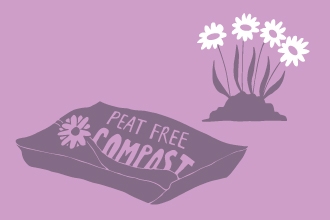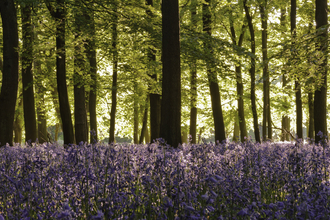
The Lancashire Peat Partnership brings together organisations working to protect and restore our precious peatlands
By pooling the specialised local knowledge of numerous experts on matters affecting both upland and lowland peatlands in Lancashire, we work to secure the best possible outcomes for these vital habitats.
We aim to promote the importance of peatland restoration, work together to deliver restoration projects across large areas of the County, secure funding, and to share knowledge, information and research findings.
Everyone involved in the Lancashire Peat Partnership is passionate about peat, and by working together we can achieve so much more than working alone.
Find out why peatlands are so special in our blog.
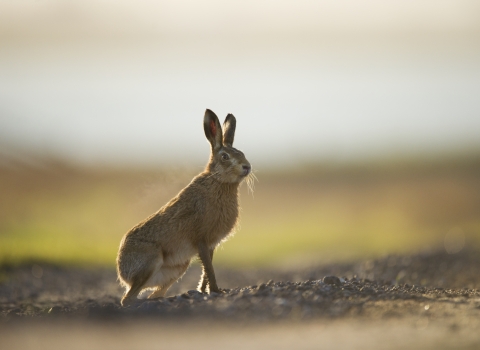
Andrew Parkinson/2020VISION
Who makes up the Lancashire Peat Partnership?
The Lancashire Peat Partnership is co-ordinated by the Lancashire Wildlife Trust and Forest of Bowland National Landscape, and made up of a wide range of partners including:
Environment Agency | Groundwork Greater Manchester | Irwell Catchment Partnership | Lancashire County Council | National Farmers Union | National Trust | Natural England | Ribble Rivers Trust | RSPB | United Utilities | The Woodland Trust | Wyre Rivers Trust
Where are Lancashire's peatlands?
Historically huge swathes of Lancashire, the North West and right across the UK would have been covered by upland blanket bogs, lowland raised mires and other peatland habitats. However, much of this has been drained for agriculture, shooting or peat extraction purposes.
Today peatlands can still be found in Lancashire on many of our uplands areas such as the Forest of Bowland AONB, the West Pennine Moors and the Rossendale ‘Gap’. Lowland peatlands include what remains of the Lancashire Mosslands, which are spread across the entire 335,000ha of lowland Lancashire, Greater Manchester and North Merseyside.
Forest of Bowland National Landscape - Nature for Climate Peatland Restoration Grant Scheme
This £1.4 million project is working to restore peatlands across the Forest of Bowland National Landscape. Funded by the Government’s Nature for Climate Peatland Restoration Grant Scheme, the project will run over four years and put 170 hectares of precious upland blanket bog habitat into restoration.
This peatland restoration project is being delivered jointly via two of the Great North Bog peat partnerships covering Lancashire and Cumbria. Key organisations involved are Cumbria Wildlife Trust, the Forest of Bowland National Landscape, National Trust, United Utilities, Abbeystead Estates and Lowther Estates.
Lancashire Wildlife Trust Peatlands Programme
Thanks to funding from the Esmee Fairbairn Foundation, Lancashire Wildlife Trust is able to host and co-ordinate the Lancashire Peatlands Partnership.
The LWT Peatlands Programme also undertakes significant work across many of our region’s lowland peatlands. This includes restoration work on peatland nature reserves, along with pioneering projects investigating alternative land management options for lowland agricultural peat such as carbon farming or wetter farming models.
Find out more about projects including:
Holcombe Moor Restoration Project
Holcombe Moor is part of the West Pennine Moors in Lancashire and owned by the National Trust. In partnership with Moors for the Future Partnership, Natural England and the Holcombe Moor Commoners’ Association, and with support from DEFRA’s Moor Carbon fund, a new programme of important work began in 2020 to improve Holcombe Moor peatland.
The project aims to restore the carbon storage capacity of the peat, improve wildlife habitats, reduce flooding downstream and improve accessibility for people to enjoy this amazing area. Stone leaky dams have been installed to slow the flow of water from the moor via the eroded gullies, bunding and bog pools created to help re-wet the peat, and sphagnum moss is being planted to re-vegetate bare peat areas.
Find out more about the Holcombe Moor Restoration Project
Pendle Hill Summit Project
As part of the Pendle Hill Landscape Partnership, the Forest of Bowland AONB team along with support from the National Lottery Heritage Fund, Lancashire Environmental Fund, Downham Estate and In Situ Arts helped put 18 hectares of peat under restoration, including:
- Re-profiling the edges of the peat hags and the gullies to reduce peat erosion
- Installing coir logs to slow the flow of water
- Covering the bare peat with heather brash cut from the hill to encourage re-vegetation
- Seeding with upland grasses and bog forming sphagnum mosses
- Planting cotton grass plug plants to help start the revegetation process.
Volunteers helped with plug planting and re-seeding the newly profiled areas and they will also continue monitoring the area in conjunction with the Forest of Bowland Priority Peat programme.
Find out more about the Pendle Hill Summit Project and watch the restoration video.
Darwen Moor Restoration Project
Led by Lancashire Wildlife Trust an area of Darwen Moor, in the West Pennine Moors has been surveyed and a restoration plan is being drawn up. Funding has been sought from the Government’s Nature for Climate Peatland Restoration Grant Scheme to put 220 hectares of this iconic landscape into restoration. This will include gully blocking with peat, stone and timber dams, hagg re-profiling, the installation of contour bunding and plug planting of classic peatland plant species.
Winter Hill Restoration Project
Following the devastating wildfire in 2018 that tore through much of Winter Hill in the West Pennine Moors, huge areas of the blanket bog peatland were left bare, with the peat at heightened risk of erosion and releasing huge amounts of carbon into the atmosphere. Since then, Moors for the Future have undertaken a number of restoration activities.
The next phase in Winter Hill’s recovery will be led by United Utilities, working with partners from across the Lancashire Peat Partnership. The latest proposals will include further grip blocking and improvements to older existing grips to allow further re-wetting, works to restore vegetation and promote the regrowth of target species such as sphagnum moss, works to restore areas of deep burn caused by the fire, and improvements to popular visitor routes.
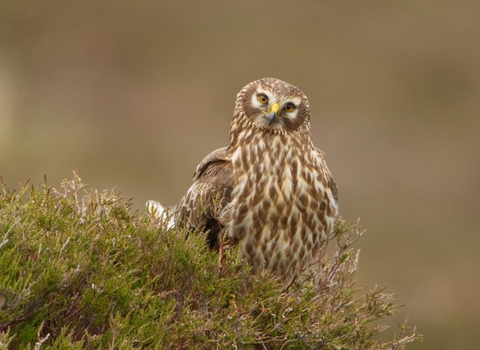
Hen harrier by Mark Hamblin/2020VISION
Blog
Keep up to date with our latest news:
-
The beauty of bunds: Peatland restoration on Darwen Moor - June 2024
- Working together to bring bog asphodel back - December 2023
- For the love of peat - November 2023
- Sundews: What's that on the Lancashire Peat Partnership logo? - July 2023
- Wildfires on our peatlands - June 2023
- A Day with Dom, Lancashire County Council Peatland Officer - Feb 2024
Great North Bog
The Lancashire Peat Partnership is also part of the Great North Bog. This is a landscape-scale approach to upland peatland restoration and conservation across nearly 7000 square kilometres of peatland soils in the Protected Landscapes of northern England (around 92% of the upland peat in England), storing 400 million tonnes of carbon. The programme aims to develop a working partnership to deliver a 10-year funding, restoration and conservation plan to make a significant contribution to the UK’s climate and carbon sequestration targets.
Funding
Across the Lancashire Peat Partnership area, a number of funding models are used to facilitate vital peatlands restoration. These include Government funding schemes alongside private sector contributions, such as those from water utility companies, corporate donors and moorland owners themselves. We are also working towards being able to fund peatland restoration through carbon credit schemes such as the Peatland Code or through the Great North Bog.
Please contact us to find out more if you are interested in supporting the restoration of our precious peatlands, benefitting the climate, biodiversity and people.
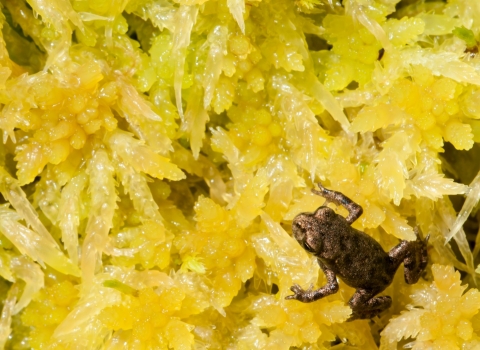
Juvenile common frog {Rana temporaria} on sphagum moss {Sphagnum sp} - Ross Hoddinott/2020VISION
Share our passion for peat
If you'd like to find out more about the Lancashire Peat Partnership, about our peatland restoration work or simply why peat is so important, please get in touch.
Alex Hubberstey - Lancashire Peat Partnership Project Co-ordinator
E: ahubberstey@lancswt.org.uk
T: 07720 103045
How you can help
Here are just a few ways that you can help our precious peatlands to recover.


